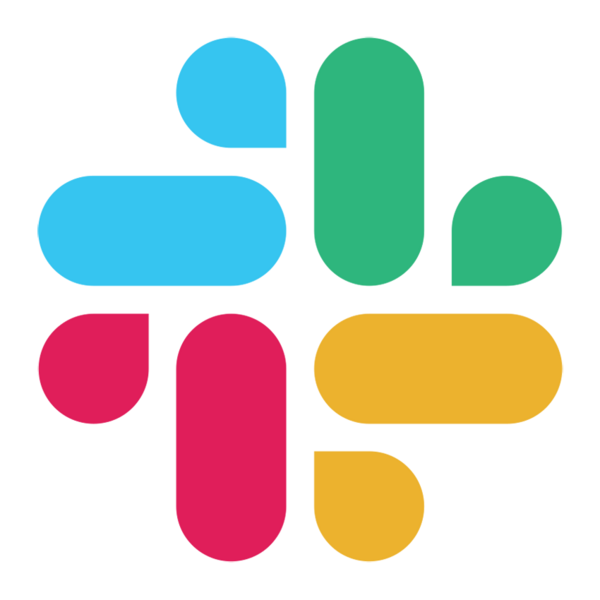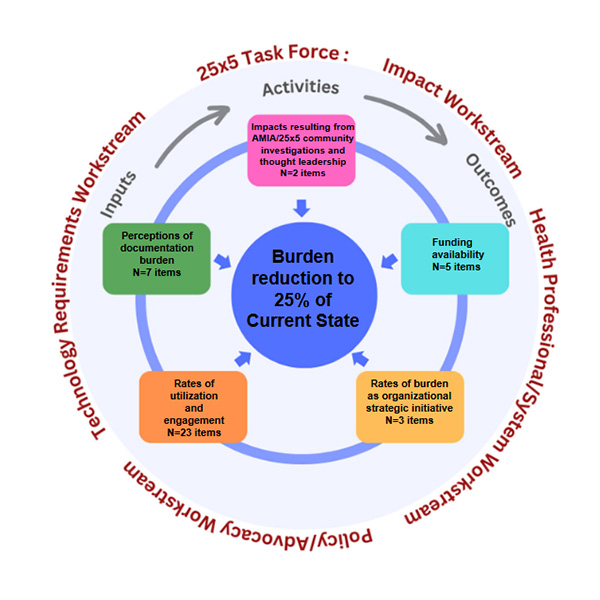The burden of clinical documentation on professionals, such as work done in the EHR, has had a proven negative impact on health care. This burden leads to a variety of negative outcomes including clinician burnout and decreased job satisfaction, increased medical errors and hospital-acquired conditions.
25x5 Task Force
Chaired by Sarah Rossetti, RN, PhD, FACMI, FAMIA, the 25x5 Task Force and 25x5 student subcommittee is structured around four workstreams:
- Health Professional/Systems
- Policy/Advocacy
- Impact
- Technology Requirements
The AMIA 25x5 Task Force is working to reduce health professionals’ documentation burden. Since the initial kick-off meeting on April 14, 2022, the task force accomplished several key short-term goals including:
- publication of the new 25x5 Toolkit to guide organizations through the process of reducing documentation burden;
- clarified 25x5 technology priorities for vendors and is circulating for public comment a roadmap of near term, intermediate and long-term priorities to reduce burden; hosted a Pitch Event and winning innovating solutions will be included in the roadmap; conducted an EHR Vendor education intervention in which participating vendors aggregated and shared training and educational resources to identify unnecessary duplicate data entry and highlight available functionality and tools that reduce documentation burden;
- conducted an environmental scan of existing efforts to reduce documentation burden, nominated documentation burden as a topic for new evidence review to AHRQ (accepted March 2023), crafted and disseminated two policy briefs, and collaborated with key regulatory agencies and accreditation groups to identify areas to support and to understand any gaps. Examples include, responding to the Office of the Surgeon General advisory, Addressing Health Worker Burnout; agreed to be a network organization for the National Academy of Medicine’s National Plan for Health Workforce Well-Being; and serve as an endorsing organization for the Regulatory Relief Coalition’s bill, The Improving Seniors' Timely Access to Care Act of 2021.
- Developed a Logic Model to measure the task force impact on reducing documentation burden.
View a timeline of achievements from the past year
Vision
A U.S. healthcare workforce free of documentation burden and focused on patient care and improved patient outcomes.
Mission
Reduce U.S. health professionals’ documentation burden to 25% of current state within five years1. We will optimize and spread across the U.S. health system impactful solutions that decrease non-value-added documentation and leverage partnerships and advocacy with health systems, professional societies, and public/private sector organizations.
Strategic Goals
- Wide adoption and utilization of task force tools and exemplars’ solutions by health professionals to reduce documentation burden across U.S. healthcare organizations.
- Greater funding for research and process improvements related to mitigation of documentation burden.
- Increased identification of strategic initiatives to reduce burden within U.S. healthcare organizations.
- Improved perception of documentation burden among health professionals.
Principles of Engagement
- No shifting of work to others (e.g., from one clinician to another)
- No erosion of care standards (e.g., quality, safety, value, efficiency, access)
- Leverage technology and existing data inputs where appropriate (e.g., reduce re-documentation of items already captured during other intake processes)
- Maximize clarity of proposed rules to minimize misinterpretation by health systems and providers.
Short-term Work Plan
Health Professional/System Workstream
The Health Professional/System Workstream created a toolkit to guide organizations through the process of reducing documentation burden. The toolkit is intended to provide resources related to governance of EHR optimization, implementation of solutions to reduce burden, and approaches to measure burden reduction.
The Health Professional/System workstream is also working toward the creation of a national learning collaborative to bring providers and health systems together to identify and share effective interventions and establish a mechanism to pilot and measure success of new interventions.
Technology Requirements Workstream
The Technology Requirements Workstream is partnering with vendors to educate current EHR users about existing functionality, tools and services that can streamline data entry and reduce the length of documentation making it easier for clinicians to identify important information within the record. EHR and non-EHR IT vendors are being asked to aggregate and synthesize training materials that show how to avoid over documentation and more efficiently document only what is necessary. Vendors are identifying existing clients in ambulatory setting willing to participate in the intervention.
The Technology Requirements Workstream is also building a five-year roadmap of HIT initiatives to reduce documentation burden. While there are a wealth of ideas and efforts within the HIT community to reduce documentation burden, many of these do not achieve their full potential due to challenges in changing dominant documentation practices in place today and structural barriers, such as interoperability.
Policy/Advocacy Workstream
The Policy/Advocacy Workstream is conducting an environmental scan of existing efforts to reduce documentation burden and meeting with regulatory and accreditation groups to identify areas to support or expand upon, avoid duplicative efforts, and identify any current gaps. The workstream actively supports and informs AMIA policy position in areas related documentation burden and advocates for consideration of documentation burden as a priority for research funding. Additionally, the workstream will support the initiatives of the other two workstreams through policy and advocacy efforts.
Impact Workstream
The Impact Workstream is establishing a standardized definition of documentation burden. This definition will help frame how the task force measures documentation burden and monitors progress in reducing burden. The workstream is also identifying various tools to measure task force progress in reaching the established burden reduction goal.
Publications
Background
Adoption of 25x5 is the culmination of a series of thought-leadership activities driven by AMIA members to acknowledge and respond to the emergent crisis. Columbia University, Vanderbilt University, and the American Medical Informatics Association (AMIA), through support from the National Library of Medicine (NLM), convened the 25x5 Symposium of decision-makers and influencers representing clinical settings, academia, industry, government, payers, professional organizations, and patients to establish strategies and approaches to reduce documentation burden on U.S. clinicians by 75%.
The symposium series included more than 30 presentations from stakeholders across healthcare ecosystem. The Final Summary Report and Executive Summary describing this work includes current challenges, exemplars, and 82 specific calls to action describe in detail.
The 82 action items were then further synthesized and prioritized into Calls to Action2 for three stakeholder groups: Providers and Health Systems, Vendors, and Policy and Advocacy.
In December 2021, AMIA assumed leadership responsibility for the 25x5 initiative to address this nation-wide problem by leveraging the collective expertise of key stakeholders in health care, industry, and policy to prioritize and implement the Calls to Action and Recommendations established by the 25x5 Symposium.
Calls to Action
1 5-year period of 1/1/2022-12/31/2026
2 Calls to Action (page 21-22) and recommendations (page 25-26) from the 25x5 Symposium Final Summary Report

